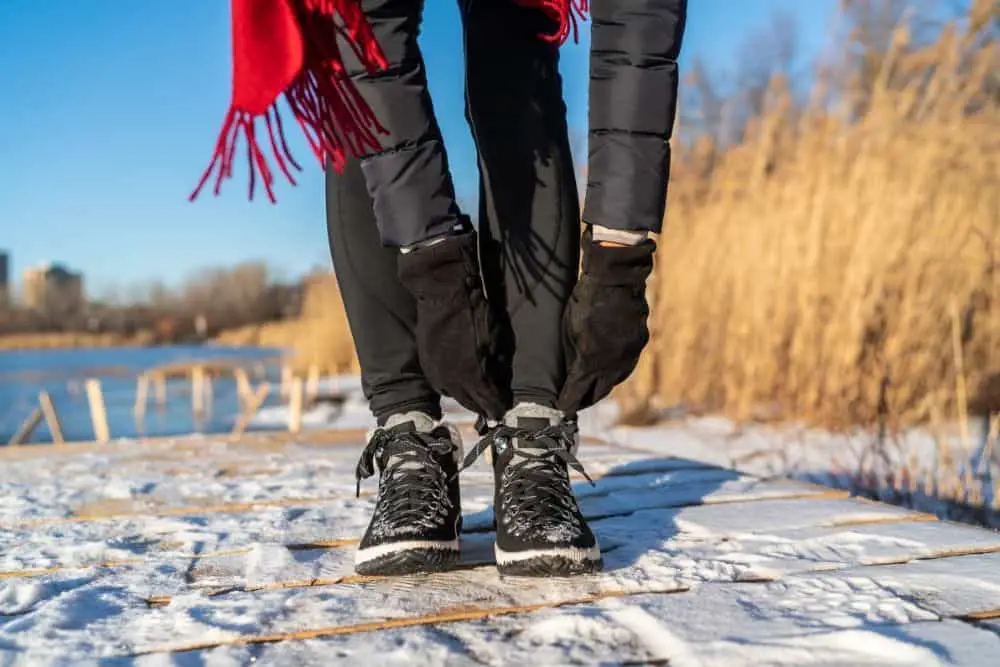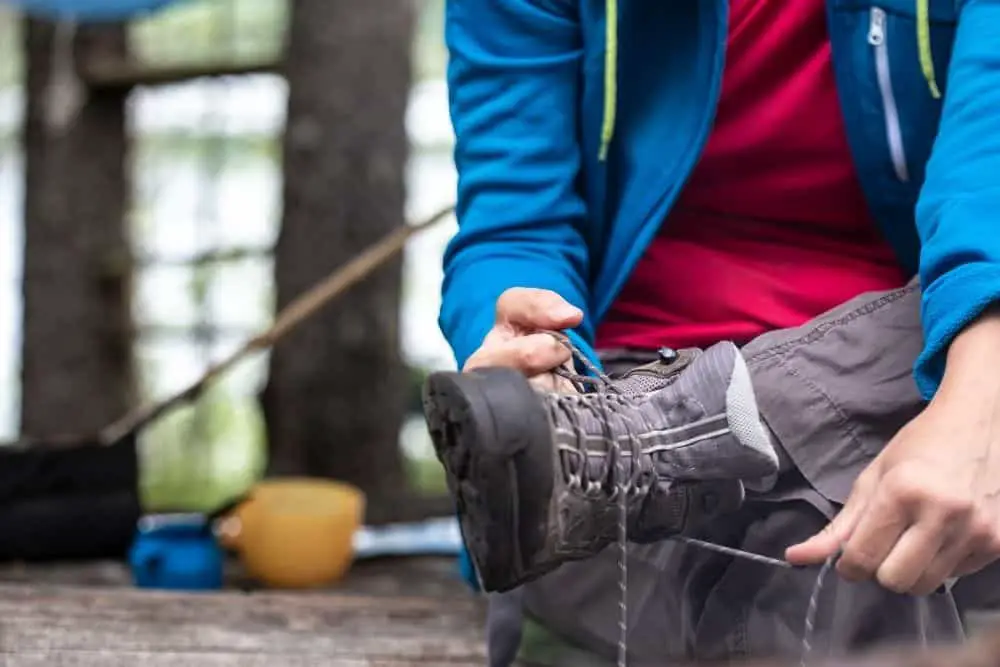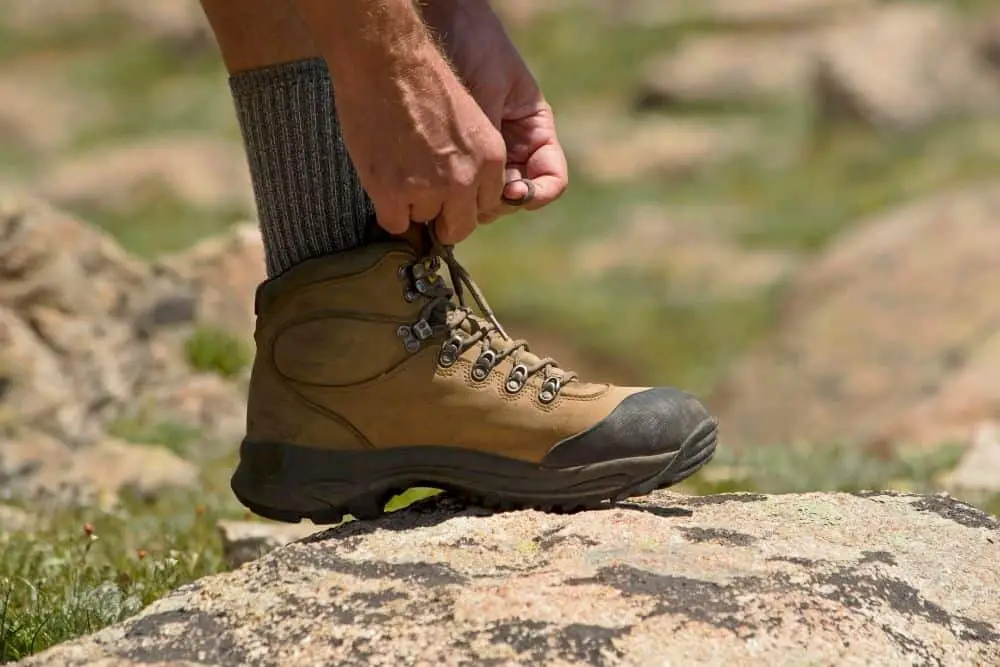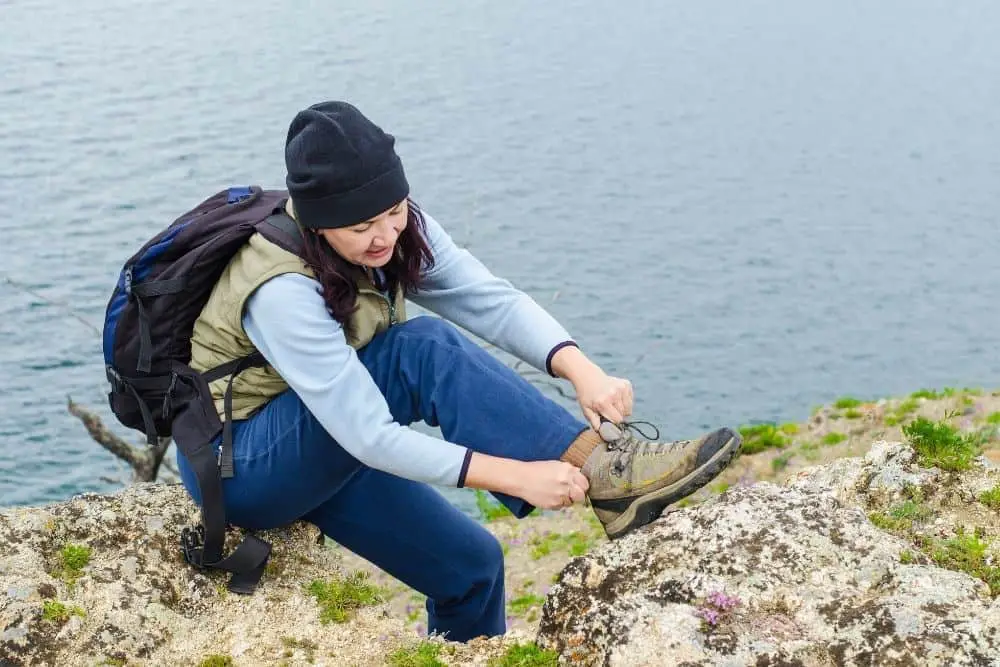One of the most important things on the trail is safety and support. One of the ways you can ensure this is through adequate ankle support. Generally, hiking boots ought to provide ankle support for hikers on the trail.
However, this may not be so if you wear unfit hiking boots, especially when they are too loose around your feet. The good thing is that you can reinforce or make up for ankle support on the trail by lacing your hiking boots the right way.
Lacing hiking boots appropriately is not so easy nor is it complicated. You may wonder whether there is anything special about tying hiking boots or whether it is different from the usual way you are used to.
On the trail, there are several ways you can lace your hiking boots for your overall comfort and safety. For example, you can lace your hiking boots to prevent blisters or feet from slipping forward on the trail.
You could also lace your hiking boots based on the hiking situation. For instance, when hiking down or up a hill. You need to be familiar with this technique because it will come in handy on the trail.
Since ankle support is very important for comfort and safety, you need to know how to ensure it by lacing your hiking boots properly. This article discusses the different ways you can lace your hiking boots for ankle support.
Let’s get started!
How To Lace Hiking Boots For Ankle Support?
You are probably most familiar with the regular crisscross method of lacing shoes. Of course, it is one of the things we had to learn to do growing up so we could wear shoes with laces.
While that is not totally bad for the trail, it may be insufficient for different hiking situations. To ensure ankle support on the trail, you would need more than the normal lacing technique.
You need to tie your hiking boots and ensure the tops of your boots fit snugly around your feet and support your weight. You can lace hiking boots for ankle support with the following lacing techniques:
Method 1: Heel lock/Racer’s loop
One of the major and most common lacing techniques on the trail is the racer’s loop, and it works well for supporting the runners on the trail. Hikers probably already know this technique as the heel lock technique.
That is, they can work well for locking your heel in place and preventing your heels from sliding up and down your hiking boots. This lacing technique is not entirely new or strange to regular hikers or hiking enthusiasts who are inquisitive about a lot of hiking information.

This lacing technique will help to ensure that the upper part of your hiking boots fits snugly around your ankle.
You should note that if your hiking boots don’t fit you properly, there is little any lacing technique can do to make it better, but once that is not a problem, you can ensure ankle support with the racer’s loop.
However, to tie this lacing technique, you would need to tighten the lace over your feet. As a result, it could put pressure or friction on the top of your foot.
In addition, if you have high arches or extensor tendonitis, this may not be best for you as it may put pressure on your feet and cause you pain. However, it is okay for people with low arches.
How is this lacing technique different from what you are used to? They are quite different, and you can find out how by following the lacing technique steps below:
Steps to follow
Step 1: Start lacing up
To tie the racer’s loop, you need to start lacing your hiking boots from the first eyelet set. To do this, you start with the regular criss-cross method you are used to.
You cross the lace to the other side and run it that way till you have almost filled up the eyelets. Stop lacing with the criss-cross method when you get to the eyelets that are closest to the top of the boots.
Step 2: Thread the lace through the last eyelets
After the criss-cross lacing, you don’t stop there. You need to thread the eyelets all the way up to the last eyelet on the hiking boots.
Instead of threading it using a criss-cross, you thread the end of the lace on the left side through the last eyelet on that side. Then you repeat the same thing for the right side as well.
By doing that, you have created a loop on each side of the boots.
Step 3: Insert laces through the loops
The next thing you have to do is insert the laces through the loop. To do that, you need to cross the lace from the left side to the right side and insert it into the loop on that side.
Likewise, you need to cross the right end of the lace and pass it through the left loop.
Step 4: Pull the laces
After inserting the laces into the loops, you need to pull till the top of the boot feels tight and snug around your ankle. However, you have to be careful here, so you don’t pull too tight to your discomfort. Make sure you are comfortable.
Step 5: Finish up
You need to ensure that the laces stay in place and don’t come loose on the trail. Therefore, you need to finish up and tie-up with a finishing lacing technique like the granny’s knot.
Pros
- It helps prevent heel slippage.
- Keep the boot snugly around the ankle.
- Ensures stability on the trail.
Con
- It is a long process.
Method 2: Two-zone lacing
Another way to lace your hiking boots for ankle support is through the two-zone lacing technique. For this type of lacing technique, you divide your hiking boots into two zones: the upper and the lower zone.
You need this lacing technique to help ensure ankle support on the trail. For this lacing technique, you are mostly concerned about the upper zone because that is where your ankle is and where you need support.

Not only will this lacing technique help to ensure ankle support, but it also helps to prevent your foot from sliding forward in your hiking boots and hurting your toes.
This lacing technique also helps to relieve pressure on the top of your foot and, at the same time, reduces friction in your heel and ankle area.
The deep-drawn area on your hiking boots separates your boots into two zones. How do you tie the upper zone for ankle support? Follow the steps below to do that.
Steps to follow
Step 1: Start lacing your boots
The first step to lacing the two-zone lacing technique is to start tying your boots. You can start lacing your boots with the crisscross method.
You cross the laces to the other side till you get the deep-drawn hooks on your hiking boots. This place is where your ankle joins the top of your foot.
The area you just crisscrossed is the lower zone. For this zone, you don’t need to tighten the laces much so that you can relieve the pressure in that area.
Besides, the purpose of this technique is to provide ankle support, so you are more concerned about the upper zone. However, you should follow the rule of thumb that your finger should not be able to go underneath the laces. They need to get that right.
Step 2: Tie lace together
Before you insert the laces into the next eyelets, which are the deep-drawn hooks, you need to thread the laces together.
Try twisting the laces together before inserting them into the deep-drawn hooks.
Step 3: Tie up the upper zone
After you have tied the knot at the deep-drawn hooks, you need to tie up the upper zone. The upper zone provides you with ankle support, so you need to make sure that you secure it.
Therefore, you tie up the remaining part using the criss-cross technique. When doing this, ensure it pulls the upper part of the hiking boots together tightly so it feels snugly around your ankle.
Step 4: Finish up
After you have laced up to the last eyelets on your hiking boots, you need to finish up and tighten the boots in place. Finish up using the granny’s knot technique or the quick pull available on some hiking boots.
Pros
- It helps secure ankles in place.
- Works for preventing foot slippage in boots.
- Relieves pressure on top of the foot.
- Easy switch between zones.
- It locks the heel in place.
Con
- It may leave the other zone vulnerable.
Method 3: Surgeon’s knot
The Surgeon’s knot is one of the most popular lacing techniques among hikers. While it may have a few benefits for hikers on the trail, it also helps with ankle support.
The surgeon’s knot secures different parts of your foot in place in hiking boots, depending on where you tie the knot. Tying the surgeon’s knot helps to make sure that your laces stop losing at intervals when on the trail.
In addition, it helps to lock the heels in place and prevent heel slippage in hiking boots. This lacing technique is very useful on the trail for different purposes, and it will come in handy.

For your safety and comfort on the trail, you need to secure your ankle in place in your hiking boots with the surgeon’s knot. This lacing technique is not exactly complicated if you know what a surgeon’s knot is.
The most important thing is knowing where to tie the knot because you obviously won’t need it all over your hiking boots. That can cause discomfort all over your feet. Two or three surgeon’s knots should do the trick for ankle support on the trail.
However, you need to ensure that you leave enough pressure points to prevent your feet from hurting too much in your hiking boots. So, how do you tie the surgeon’s knot technique? Watch how to tie a surgeon’s knot here.
Steps to follow
Step 1: Start lacing up your boots
You don’t start tying the surgeon’s knot from the first set of eyelets. The first step to doing that is to start lacing up your boots using the usual and common lacing technique.
Lace the criss-cross method through the first and second eyelet sets.
Step 2: Tie the surgeon’s knot
- Method one:
After starting with the criss-cross, you need to start tying the surgeon’s knot to keep your foot in place in your hiking boots. To tie the surgeon’s knot, you need to thread or twist the laces together two or three times.
After twisting, you then insert the lace ends into the next set of eyelets through the criss-cross. You can do the same thing for the next set of eyelets to relieve your feet or a pressure point and prevent your feet from hurting.
Then, you can tie the next surgeon’s knot there by twisting and repeating the same thing you did for the first knot you tied. After that, you can tie an extra surgeon’s knot before finishing up.
- Method two:
Another way you can tie the surgeon’s knot is by tying the crisscross technique up to the deep-drawn hook. Then, you can tie the surgeon’s knot around your ankle area.
There, you can tie the remaining eyelets with the surgeon’s knot, secure your ankle and heel in place, and ensure ankle support on the trail. Regardless of which route you choose, make sure you relieve some pressure points and save yourself some pain.
In addition, you should tighten the knot enough to keep your ankle in place.
Step 3: Finish up
When you are done with tying your surgeon’s knot, if you used the first method above, you need to finish tying up your hiking boots. You can finish up by tying the criss-cross technique up to the last eyelets.
Since this place matters a lot, you should ensure it is tight enough to lock your ankle in place and prevent it from moving around in your boots. Then you can tie the tips with the granny’s knot to secure the laces in place.
This also applies to the other method to secure the surgeon’s knots in place.
Pros
- Helps with ankle support in boots.
- Relieves pressure points.
- Ensures heel and foot lock in hiking boots.
- Prevents laces from untying on the trail.
- Prevents heel slippage on the trail.
Cons
- Can be stressful to tie.
- Can hurt feet when it is too tight.
Method 4: Window lacing technique

Another way to lace your hiking boots for ankle support is the window lacing technique. Usually, people use this lacing technique to relieve pressure on the top of their feet.
But more than that, you can use them to support your ankle on the trail. Some people know this method as the “box lacing technique,” because, basically, you create a box-like window on top of the hiking boots.
This helps you to feel less pain on the trail and makes you more comfortable. And finally, you can support your ankle. How do you tie the window technique for ankle support?
Steps to follow
Step 1: Start lacing up
The first thing you need to do is to start lacing up your boots. You can do this by using the criss-cross method of lacing shoes for the two sets of eyelets on your boots, or up to the pressure point on your feet.
Step 2: Create the window
After crisscrossing the first two sets of eyelets, you run the lace through the next hook. But instead of crisscrossing, you run the left end of the lace to the next hook above it, and you do the same for the right.
You can do that for two sets of eyelets, depending on how much pressure you need to relieve.
Step 3: Complete lacing up
After creating the window, you then finish lacing your boots to the last eyelets using crisscross. You could also tie it using the surgeon’s knot to tighten the lace.
Step 4: Finish up
After lacing up, finish tying your boots using the granny’s knot.
Pros
- Good for pain relief.
- Supports ankles on the trail.
- Makes hiking boots comfortable
Con
- Doesn’t relieve all pressure points.
Method 5: Relaxed ankle lacing

You can also support your ankle in hiking boots by tying them using the relaxed ankle lacing. This lacing technique can help reduce ankle pain on the trail as well as support your ankle.
This method is not so hard to tie; you just need to tie your hiking boots normally and tie the last eyelets differently to relieve pressure in that area.
Steps to follow
Step 1: Lace up your boots
To wear this method, you need to lace your boots up. Start lacing up using crisscross, pull tightly and leave the last pairs of eyelets.
Step 2: Tie the last eyelets
To tie the last eyelets, you need to insert your laces in a different way. Instead of inserting it inside out, you do it in reverse.
That way, the laces come out from beneath rather than from above.
Step 3: Finish up
After that, you need to finish up by tying the hiking boots end to secure your ankle in the boots.
Pros
- It’s not a complicated process.
- Relieves ankle pain.
- Helps with ankle support
Con
- Not a permanent solution for ankle pain.
Conclusion
Buying hiking boots that fit around your feet might not be enough. How you tie them on the trail matters as well, to make you comfortable and safe on the trail. You can tie your hiking boots in different ways to ensure ankle support on the trail.
Some of the ways to lace hiking boots for ankle support are by tying the surgeon’s knot, two-zone lacing, and the runner’s loop. We have written a detailed step-by-step guide on how to laces these techniques.
The important thing is that your hiking boots are the right size and not too loose around your feet, or else these lacing techniques can be inconsequential in ensuring ankle support.
Another thing is to ensure you tighten the laces enough around your feet and ankles to ensure the boots are snug around your feet.
However, you should be careful when tying your hiking boots so you don’t put too much pressure on some areas of your feet. You should also finish up effectively so the laces don’t untie in the middle of the hike.

